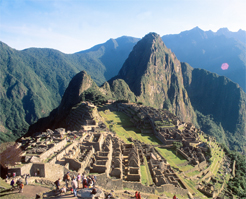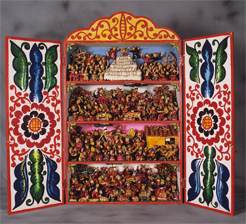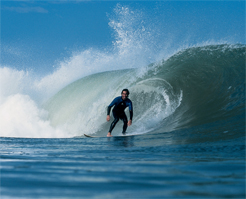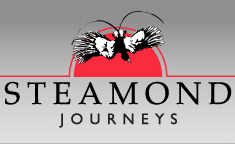Peru Travel Guide



Telephone:
E:
The Country
Peru is located on the western side of South America. Its territory borders the Pacific Ocean to the west and bounded on the north with Ecuador, on the northeastern with Colombia, on the east by Brazil, on the southeast by Bolivia and south to Chile. Because of its geographic position and its tropical location, the presence of the Andes and both the Humboldt and El Niño currents, Peru is the earth’s most ecologically diverse country. Eighty-four of the one hundred and four ecosystems in the world, and twenty-eight of the thirty-two climates on the planet can be found here. Additionally, it is one of the world’s leading countries in terms of variety of species and habitats.
Area
498,222 square miles (1,285,215 km²)
General Informaton of Peru
Official name: Republic of Peru
Capital city: Lima, 7,665,222 inhabitants (estimated 2008)
Official languages: Spanish. English is widely spoken.
Currency: Nuevos Soles S/. (Dollars and Euros can be easily changed.)
Demographic Facts
Population: 28,220.764 (2007 est.)
Urban & rural population: Urban 76%, Rural 24% (2008 est.)
Ethnicity: Indian 44%, Mestizo 34%, White 16%, Black, Chinese and Japanese 5%
Buses
Bus service covers all destinations within the country, except for some cities located in the Amazon jungle. Different rates determine comfort level and whether it is direct service without stops or if there are stops along the route.
Car Rental
A good way to travel through Peru to tourist destinations is with a car. The independence and comfort offered added to a road network of more than 70,000 kilometers, make access possible to the most interesting tourist destinations of the country.
Some of the larger brand name rental car companies are listed below but most often cheap car rentals can be found by using the smaller companies.
• Alamo
• Avis
• Budget
• Dollar
• Enterprise
• Hertz
• National Car
Climate
One of the great advantages of visiting Peru is its year-round sunshine. Although most of the world’s climates can be found somewhere in Peru, the weather is generally mild and does not present difficulties for travelers. Some cities along the coast have a mild, humid climate. In the northern cities, near the border with Ecuador, the climate is pleasant and sunny all the year round. In general, the climate at altitudes between 3,300 and 8,200 feet (1,006 and 2,500 masl), such as Arequipa or Ayacucho is cool yet sunny throughout the year. At 11,500 feet or more (3,505 masl), there are only two seasons: the rainy season (December through March) and the dry season with sunny days and chilly nights. The cities of Cusco, Puno, Cajamarca and Huaraz have this type of climate.
On the other hand, the whole of the jungle region, from Iquitos to Madre de Dios (Puerto Maldonado), is always hot, with year-round temperatures averaging between 75°F and 83°F (24°C to 28°C).
Cruise Ships
Lima, Peru on the western coast of South America is a cosmopolitan city and a gateway to cruise ships arriving from the Far East that have sailed across the South Pacific. Cruises sailing from North America to Santiago or Valparaiso also often include Lima as a port of call on repositioning cruises between the Americas. Callao is the biggest and most important port of Peru . It is located only 15 kilometers from Lima , the capital of the Country. Other main Peruvian ports are : Salaverry in Trujillo (North) and General San Martín in Pisco (South).
Customs & Immigration
Each passenger is allowed two bags of up to 55 pounds (25 kilos) each, plus a 11 pounds (5 kilos) carry-on luggage, photo or video camera, wheel chair, or baby carriage can be transported free of charge if there is space availability.
Diving
Peru is a cold water diving destination that has it all: an amazing species diversity, huge numbers of animals covering every centimeter of habitat with a carpet of life, sea lions, kelp forest, rock walls and ship wrecks. More than 1000 species of fish are registered in Peru, 1400 species of mollusks and over 300 crustacean species.
Dress
It is advisable to bring a variety of clothing, depending on the places to visit. If the traveling is through the coast, it’s appropriate to wear clothing for fall. If traveling to the mountains, winter clothing will be necessary. Be prepared to dress in layers in the jungle. If the plan is to enjoy some time at the beach, bring light summer attire. Comfortable shoes, a hat and sunblock to protect you from the sun’s strong rays in the mountains and from the heat of the jungle are recommended.
Drink
Bottled mineral water, with or without carbonation, soda drinks like Inca Kola and Coca-Cola are available in all hotels, ships and restaurants, as well as Cristal, Pilsen and Cusqueña beer. Coffee and tea are usually served at the end of meals. The “chicha morada” is the typical drink of Peru, and it is generally consumed in the coast.
Eating Out
Anyone who has been to Peru can vouch for its wonderful cuisine. Sophisticated restaurants, awarded several forks, reflect the diversity of a nation that has blended its native traditions with the cuisine of Europe, the Middle East, China , Africa and Japan. The result: unique flavors that make Peruvian cuisine one of the finest and most varied in the world.
Today the gastronomy bounty can be enjoyed in traditional restaurants and also through the creations of a new generation of chefs who have achieved international recognition for their imaginative use of traditional ingredients and recipes with haute cuisine techniques. Peruvian restaurants throughout the country can be a fantastic and inexpensive treat. Most restaurants take major international credit cards.
Electrical Current
Electricity in Peru is 220 volts AC, 60 cycles. Some hotels have 110 volts AC or adapters.
Guide Books
There is no better time investment than reading up before you travel to Peru . There are a number of great tour guide books covering Peru. Featuring top travel guides such as Lonely Planet Peru and Frommer's Peru.
Health & Insurance
No inoculations are required for entry. Travelers with heart conditions or high blood pressure should check with their physicians about high-altitude travel, as well as preventive measures for visiting tropical areas. Bottled water is advised and available everywhere. For guests traveling to Peru’s Amazon Region, a yellow fever vaccination is required. Altitude sickness, known as soroche in Peru, is occasionally a problem for visitors traveling directly from the coast or jungle regions to the high Andes, above 2,500 meters (8,000 feet). The best way to prevent it (headache, dizziness, fatigue) is to eat lightly, and drink plenty of fluids. It is recommended to ascend gradually to become acclimated and rest on the first day of your arrival
Do I need any shots?
No vaccinations are required for travel to Peru. Most travelers receive inoculations for Hepatitis A, Typhoid Fever and Tetanus. If traveling to the Amazon region, you should consider Malaria prophylaxis and Yellow fever.
Language
Peru's official language is Spanish. Quechua is the second official language, and is widely spoken in the sierra (highlands). English is spoken in major visitor centers.
Media
Privately-run broadcasters and newspapers dominate the Peruvian media scene, with the state-run media having relatively small audiences. The airwaves of Lima are home to dozens of radio stations and several TV services. Many radio stations and regional newspapers are available in the provinces
Money
The official currency in Peru is the Nuevo Sol (S/.), which is divided into 100 centimos. There is no restriction on the amount of foreign currency or travelers checks brought into Peru.
Banks & Credit Cards
Most businesses and Bank offices are open Mondays through Fridays from 9 a.m. to 6 p.m., although some banks also open Saturday mornings. You can withdraw money with major credit cards at the principal banks. In major cities, most hotels, restaurants and shops accept international credit cards and travelers checks. Nevertheless, it is always advisable to carry some cash. The use of U.S. Dollars is allowed. You may pay for goods and services directly in US Dollars or in Soles at the daily rate of exchange. ATM's are easily found throughout the main cities. Cash advances can be made at most banks or ATM's.
Are ATM machines available?
Yes. There are ATM machines in the main cities such as Lima and Cusco. We recommend using the ones located inside some hotels, stores, restaurants or banks. Consult with your guide for safety recommendations .
The People
Peru is a nation of mixed ethnic origins. Throughout its history, Peru has been the meeting ground for different nations and cultures. As a result of this encounter, and later enriched by the migration of Africans, Asians and Europeans, Peruvians emerged as the representatives of a nation whose rich ethnic mix is one of its leading characteristics.
Public Holidays
• January 01: New Year's Day
• March / April: Easter – Holly week
• May 01: Labour Day
• June 29: St Peter's and St Paul's Day
• July 28 & 29: Independence Day Celebrations
• August 30: St Rosa of Lima Day
• October 08: Angamos Battle
• November 01: All Saints' Day
• December 08: Immaculate Conception
• December 24: Christmas Eve (half day)
• December 25: Christmas Day
Railways
Total: 1,988 km
Standard gauge: 1,608 km, 4 ft 8 1⁄2 in (1,435 mm) gauge
Narrow gauge: 380 km, 3 ft (914 mm) gauge
There are two unconnected principal railways in Peru.
The Ferrocarril Central Andino (FCCA; the former Ferrocarril Central del Perú) runs inland from Callao and Lima across the Andes watershed to La Oroya and Huancayo. It is the second highest railway in the world (following opening of the Qingzang railway in Tibet), with the Galera summit tunnel under Mount Meiggs at 4,783 m (15,692 ft) and Galera station at 4,777 m (15,673 ft) above sea level. In 1955 the railway opened a spur line from La Cima on the Morococha branch (4,818 m (15,807 ft) above sea level) to Volcán Mine, reaching an (at the time) world record altitude of 4,830 m (15,846 ft). Both branch and spur have since closed to traffic. From Huancayo the route is extended by the Ferrocarril Huancayo - Huancavelica. In July 2006 FCCA began work to regauge the Huancavelica line from 3 ft (0.91 m) to standard gauge and it was finished in 2010. There was also a proposal for a 21 km tunnel under the Andes. The Ferrocarriles del Sur del Perú (FCS), now operated by PeruRail, runs from Cuzco to Puno on Lake Titicaca. From Cuzco, PeruRail runs the 3 ft (0.91 m) gauge line to Aguas Calientes for Machu Picchu.
Taxis
There is a sales tax added to purchases; hotels and restaurants charge sales tax and service.
Telephone Services
International calls to Peru: 00-51-city code + phone number.
International and long distance national calls can be made from public pay phones. Country and city codes are normally shown in the telephone booths.
Public telephones accept coins and phone cards that are sold in stands and supermarkets. Make certain that you are buying the phone card from the company you wish to use. It is possible to make collect calls from some public phone booths.
Time
Local time on the mainland is Greenwich Meridian Time minus 5 hours (Eastern Standard Time in the United States). Valid though all Peru all year around.
Vaccinations
No inoculations are required for entry. Travelers with heart conditions or high blood pressure should check with their physicians about high-altitude travel, as well as preventive measures for visiting tropical areas. Bottled water is advised and available everywhere. For guests traveling to Peru’s Amazon Region, a yellow fever vaccination is required. Altitude sickness, known as soroche in Peru, is occasionally a problem for visitors traveling directly from the coast or jungle regions to the high Andes, above 2,500 meters (8,000 feet). The best way to prevent it (headache, dizziness, fatigue) is to eat lightly, and drink plenty of fluids. It is recommended to ascend gradually to become acclimated and rest on the first day of your arrival.
Visa
Valid passports are required for entry into Peru. No visas are needed for stays of up to 90 days. Before landing, your airline will give you an embarkation /disembarkation card to be filled out and presented to the Immigration officer.
Others
text here?
Tipping
As in many places, gratuities are customary, but entirely at guest's discretion. Guidelines for tipping will be found in the "Welcome Kit" you receive upon arrival.
Park Fees
Visitors to Machu Picchu, archeological sites, and National Parks and Natural Reserves must pay entrance fees. Such prices vary and may not be included in tour rates.
